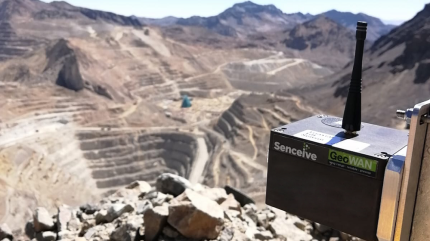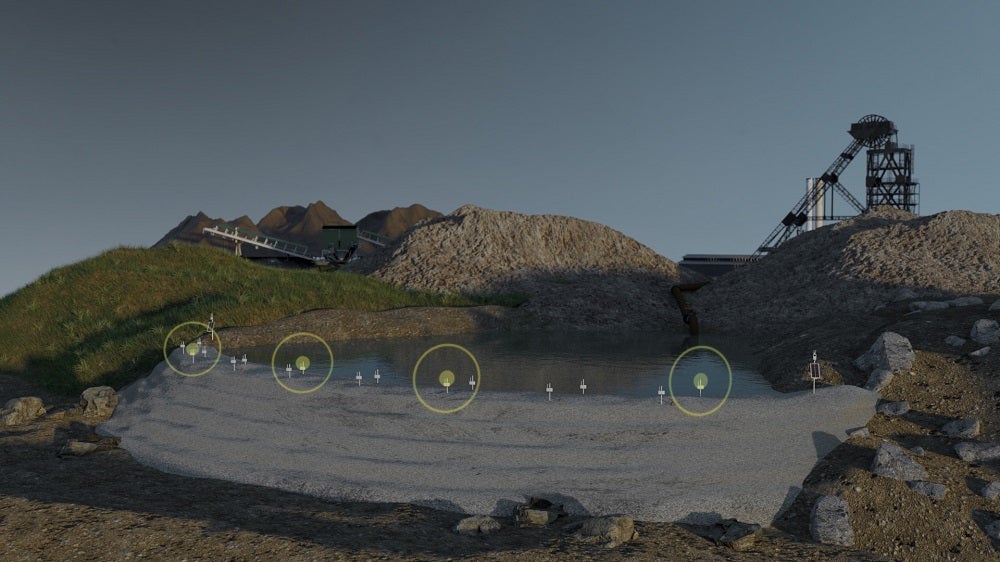
There are three areas of a typical mine which share the attributes of being high value, and vulnerable to relatively minor slope failure events which can have consequences that extend far beyond the asset itself. These are:
- Tailings dams and dumps
- Open pit walls
- Mine infrastructure such as haulage railways and processing facilities
There is a proven track record of wireless monitoring solutions being applied in all three of these application areas. The intelligent responsive monitoring solution Infraguard™ has been developed by engineers at Senceive specifically to provide early warning of slope failure. The wireless remote monitoring system is unique in that it uses smart FlatMesh™ tilt sensors that operate in two modes. For most of their ultra-long (>10 years) lives they are in a semi-dormant state where they send scheduled updates, at say 30 minute intervals. But when they detect movement outside pre-set thresholds they “wake up” and can provide virtually continuous data. They are also able to trigger bespoke cameras to send images of the site to inform remote stakeholders of events on the site long before they can get boots on the ground. More than 50,000 InfraGuard sensors are in operation around the world and there are numerous examples where early warning signs of events such as landslides have been spotted two to four days before the ground has given way.
Tailings dams and dumps
Failure of these man-made structures is all too common and the consequences can include loss of life, environmental and reputational damage, interrupted production and financial penalties. There is a view in the industry that most of the high profile failures of recent years could have been predicted if better monitoring solutions were in place and if the data were being assessed by the right people.
So what do we mean by “better monitoring solutions”? In most cases this will entail the integration of different instruments into a combined system to assess multiple parameters. On a tailings dam, for example, this could mean the use of wireless tilt sensors to assess surface deformation, and borehole instruments such as in-place inclinometers (IPIs) and piezometers to monitor deep ground movement and pore water pressure. This a powerful combination because failure events such as landslides on dumps and breaches of tailings dams are seldom caused by one factor. They are generally caused by the interaction of numerous factors such as geological structure, water movement and the presence of unstable or low friction layers. It is because there are usually multiple causal factors that it is vital to measure multiple parameters.

Open pit walls
Continuous access to precise data can help mine managers move away from a deterministic approach, where slope angles are designed to a strict theoretical factor of safety, to a wider risk-based approach where a mine is designed for optimal safe performance. One outcome of this can be slopes that are steeper, yet also safer. This is because a slope that is continuously monitored can be steeper than one that is not, provided the data are analysed in the context of a robust ground model by suitably qualified geologists or mine engineers. This can result in significantly reduced stripping and lower recovery costs. Furthermore, a slope that is moving can still be mined if monitoring data demonstrate a predictable and safe pattern of long-term controlled movement.
Mine Infrastructure
The integrity and performance of processing facilities such as pipes, conveyors and crushers is dependent on the stability of the ground they are built on. Where there is concern about potential vulnerability to deformation or landslides a prudent first step can be the deployment of a wireless monitoring system. Because the instruments are small, robust, and require no cables for power supply or comms they are easy to install on even the most complex structures.
Haulage railways are another critical aspect of mine infrastructure that are exposed to the risk of ground movement. The InfraGuard system has been used to monitor railway earthworks since 2019 and is ideal for remote sites where regular inspection is costly or inconvenient. Until now, most wireless systems have relied on cellular communications – which are not always available at mines in remote areas. The recent introduction of a SattComms capability means that the powerful technology can now be deployed at the world’s most remote mine sites, meaning that users benefit from continuous data and automated alerts using kit that is cost-effective and drastically cuts the need for site visits. The first SattComms system has been running successfully on a mining railway bridge in the tropical rainforest of Gabon, West Africa for over three months and provides remote teams with frequent updates and automated alerts if preset movement thresholds are breached.

Conclusion
The risks associated with ground movement and slope failure can be costly and damaging to mine operators. Wireless monitoring technology such as the Senceive InfraGuard system provide an affordable and proven means of mitigating these risks.
To read more about remote monitoring for mining, click here.


